Exploring the Unique World of Parrot Species
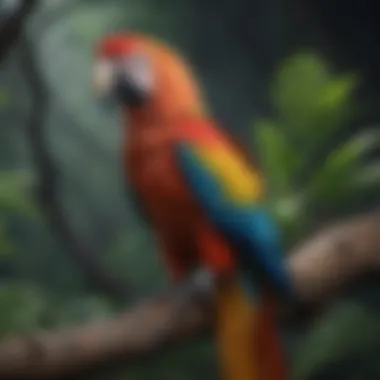
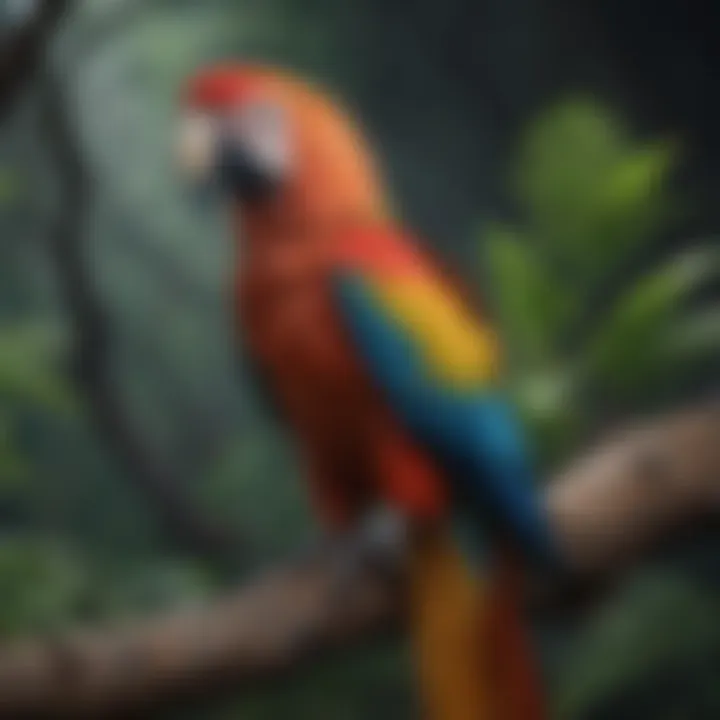
Intro
Parrots are often considered one of the most vibrant and intelligent groups of birds on the planet. Their ability to mimic human speech, combined with their stunning plumage, makes them irresistible to many. With over 393 species ranging from the tiny budgerigar to the majestic macaw, there's a wealth of diversity among these birds. Each species comes with its unique traits, habitats, and behaviors, often influenced by where they live. Understanding these differences is crucial for anyone looking to care for a parrot, whether you are an experienced bird owner or just beginning your journey.
As we embark on this exploration of parrots, we’ll delve into the specifics of their requirements. This includes insights about their care, behavioral nuances, essential nutritional guidelines, health considerations, and enriching activities that can make a parrot thrive in domestic environments.
For those enthusiastic about aviculture, comprehending the priciples of responsible ownership extends beyond mere appreciation of these magnificent creatures. It touches on conservation efforts as well, emphasizing how we can all play a part in preserving the habitats and species that face threats in the wild. Through this comprehensive guide, we aim to deepen the reader's understanding and appreciation of these remarkable birds, shining a light on the responsibilities and joys that come with parrot ownership.
Let us start with fundamental care tips that every aspiring bird owner should know.
Preface to Parrots
Parrots are captivating creatures that have been the star of many conversations, ironically enough. They charm us not just with their vibrant colors and playful antics, but also with their innate ability to mimic sounds. This introduction to parrots is more than mere words; it unveils layers of understanding about these feathered wonders.
The central focus here lies in the diversity of parrot species and the unique characteristics they bring to their environments. Whether you are a seasoned bird enthusiast, an aspiring parrot parent, or just someone curious about avian life, grasping the varied aspects of parrots enriches your appreciation for them. It’s not just about squawking voices and beautiful plumes; it’s about understanding the roles they play in their ecosystems and the emotional bonds they can create with humans.
Understanding Parrot Taxonomy
Getting to know parrots means understanding parrot taxonomy, which categorizes these birds into their respective families and genera. Parrots belong mainly to the family Psittacidae, which can further be broken down into several genera, like Amazona, Psittacus, and Macropygia. Each genus encompasses a variety of species, each more fascinating than the last. For instance, the African Grey Parrot, renowned for its high intelligence and social nature, falls under the genus Psittacus.
This classification matters because it influences everything from their behaviors to their habitats. The way a parrot behaves or interacts with its surroundings can provide insight into its evolutionary adaptations. Those looking to keep parrots as pets should consider these distinctions. A bird’s lineage not only informs its potential lifespan and health but also its needs for social interaction and mental stimulation. Understanding taxonomy thus serves as a roadmap for potential owners.
Significance of Parrot Species Diversity
The diversity of parrot species isn't merely an academic interest; it holds substantial significance in the broader context of environmental health and human interaction. With close to 400 species spread across tropical and subtropical regions, the variety of parrots reflects a wealth of evolutionary success stories. From the macaws of South America to the cockatoos in Australia, each species has adapted to its habitat in unique ways that contribute to ecological balance.
This diversity is crucial for multiple reasons:
- Ecosystem Health: Parrots play pivotal roles in seed dispersal which helps maintain forest dynamics.
- Cultural Significance: Many indigenous communities view parrots as symbols of freedom and spirituality, weaving their imagery into art and folklore.
- Conservation Awareness: Recognizing the range of species sparks interest in conservation efforts; understanding that some parrots are endangered elevates the urgency of protecting their habitats.
"A healthy population of parrots reflects the health of their ecosystems—an array of colors painting a vibrant picture of biodiversity."
In sum, the comprehension of parrot taxonomy and the significance of their diversity enriches our understanding of both the avian world and our role in it. The more we know, the better equipped we are to foster their well-being, whether in the wild or as companions in our homes.
Key Characteristics of Parrots
Understanding the key characteristics of parrots is essential to appreciating these intriguing species. Not only do their physical traits help them adapt to their environments, but their cognitive abilities also reveal much about their behavior and intelligence. When discussing parrots, one cannot overlook how these unique aspects contribute to their survival and appeal to avian enthusiasts.
Physical Attributes
Feather Structures
Feathers are central to a parrot's identity. Not only do they provide insulation, but the colorful plumage also plays a role in courtship and social signaling. Each feather structure has its own unique characteristics.
Parrots possess contour feathers, which are the primary feathers covering their bodies. These feathers create that lush, vibrant appearance that captivates bird lovers. The arrangement and coloration vary dramatically among species, adding variety to their visual appeal. Colors serve not just for beauty; they can help species blend into their habitats, which can act like a cloak against predators. However, maintaining this plumage requires regular preening, highlighting a disadvantage: it can be time-consuming, and neglecting it can lead to health issues.
Beak Morphology
Parrot beaks are not just designed for noshing on seeds and fruits; they are tools tailored to their lifestyles. The powerful, curved beak structure enables them to crack open hard nuts and seeds efficiently. An intelligent adaptation, it aids not just in feeding but also in climbing and foraging.
For instance, the macaw’s beak is one of the strongest in the parrot world, facilitating its ability to break down the toughest of fruits. This morphology benefits the macaw but can also be a double-edged sword; a strong beak can lead to significant damage if a macaw feels threatened or territorial, causing challenges for prospective owners.
Size Variations
Size can significantly influence both a parrot's behaviors and care requirements. Parrots vary tremendously in size, from the tiny budgerigar to the impressive hyacinth macaw. These variations can impact everything from diet to habitat choices and care considerations.
A notable point is that larger parrots generally require more space, both in terms of the cage and free flight opportunities, compared to smaller species.
But some smaller parrots, like the quaker parrot, have big personalities. While they may not take up much physical space, they require a lot of social interaction and stimulation.
Cognitive Abilities
Learning and Mimicry
One of the most celebrated traits of parrots is their ability for learning and mimicry. This capability runs deeper than mere entertainment; it speaks to their social structures and cognitive development. Parrots often learn through observation and social environment, mimicking sounds, voices, and even human words.
A highlight of this is the African Grey Parrot, known especially for its capacity to understand and replicate human speech. This ability intrigues researchers and bird enthusiasts alike, shining a light on the mental complexities of these birds. However, their mimicry can be a double-edged sword; while it provides fun and engagement, it can also lead to behavioral challenges if not properly managed.
Problem Solving Skills
Parrots exhibit remarkable problem-solving skills that showcase their intelligence. They can navigate complex puzzles and challenges, which signify their ability to strategize and innovate. For instance, caiques are known for their playful problem-solving, showing not just intelligence but creativity.
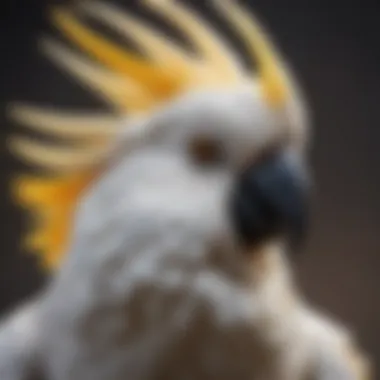
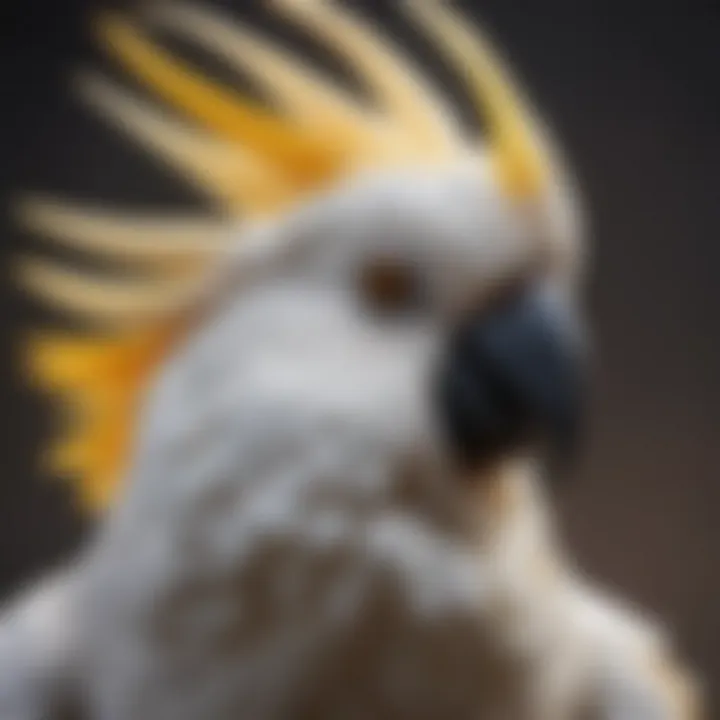
This quality not only enhances their ability to find food in the wild but also makes them engaging companions for those inclined to keep them as pets. However, these needs can lead to boredom and frustration if they’re not mentally stimulated, potentially resulting in destructive behaviors.
"Understanding the key characteristics of parrots enriches appreciation and informs responsible ownership, suitable habitats, and conservation efforts."
Popular Species of Parrots
When one thinks about parrots, it's natural to gravitate towards the more well-known species that have captured the hearts of bird enthusiasts. Understanding these popular species is key for anyone interested in aviculture or simply seeking a joyful companion to share their life with. This section not only sheds light on the characteristics of these birds but also underscores their significance in captivity and conservation. Learning about these species empowers potential owners to make informed decisions about their feathered friends.
Amazons
Amazons are among the most lively and striking parrots, known for their somewhat stocky build and a penchant for playful behavior. These birds boast a variety of colors and patterns, making them visually appealing to many. But beyond their looks, Amazons are social creatures, thriving on interaction with humans and other birds.
- Vocal Abilities: Their vocal prowess is noteworthy. Many owners find joy in their ability to mimic sounds and words. However, this also demands a commitment to training, as their instincts to vocalize can lead to noise if not properly managed.
- Social Engagement: They require plentiful socialization, or you run the risk of boredom-induced behavior issues. A pet Amazon can turn into a great companion who actively engages in family activities.
Macaws
Macaws are the giants of the parrot world, both in size and personality. These colorful beauties come in various species with vibrant feathers that leave a lasting impression. Despite their size, they are known to develop strong bonds with their owners.
- Intelligence: Macaws are renowned for their intelligence, often requiring mental stimulation through toys and strategies. If their environment lacks stimulation, they can become destructive.
- Lifespan: With impressive longevity, often living upwards of 50 years, committing to a Macaw means a long-term relationship that requires dedication and care.
African Grey Parrots
African Grey Parrots are frequently lauded for their intelligence and exceptional mimicry. These parrots are medium-sized and primarily grey with striking red or black accents on their tails. Their ability to learn human language and understand context makes them a favorite among bird owners.
- Cognitive Skills: Their cognitive abilities are impressive, capable of solving puzzles and responding to commands. This level of intelligence means they thrive on interaction and mental challenges.
- Interactive Companionship: Owning an African Grey provides a unique interactive experience, but it requires a significant time investment from the owner to ensure emotional well-being and socialization.
Cockatoos
Cockatoos are captivating with their distinctive crests and affectionate natures. Ranging from small to large sizes, they all share a playful demeanor that can charm just about anyone. There’s a powerful need for companionship within this species, often resulting in a strong bond with their owners.
- Affectionate Nature: Cockatoos are known to show affection, but they also may become overly needy if left unattended for long periods. Owners must be prepared for separation anxiety in these birds.
- Grooming Needs: Their feather structure requires regular grooming to keep them healthy and vibrant, as well as to help manage the dust produced by their feathers, which could affect both the bird and the owners in close proximity.
Budgerigars
Budgerigars, or budgies as they are widely known, are perfect for those new to bird ownership. These small parrots are friendly, social, and come in an array of colors. Budgies provide a great entry point for budding aviculturists since they’re generally easy to care for.
- Social Creatures: Budgies thrive on social interaction. Many owners choose to keep pairs to ensure they have a companion to bond with, which alleviates loneliness and boredom.
- Training Potential: They are also quite trainable, with the potential to pick up basic commands and phrases, delighting their owners in the process.
Understanding the diversity of popular parrot species equips prospective owners for the responsibilities that come with keeping these intelligent creatures. By carefully considering the specific needs and characteristics, your journey into aviculture can be a rich and rewarding experience.
Habitats of Parrots
The habitats in which parrots thrive play a crucial role in their development, behavior, and overall survival. Understanding these environments helps in appreciating their unique adaptations and the challenges they face. Parrots are not just beautiful birds with striking plumage; they are also representatives of complex ecosystems. When discussing the habitats of parrots, one must consider the interplay between climate, food sources, and social structures, which together influence their life patterns.
Rainforest Ecosystems
Rainforests are often regarded as the paradises of biodiversity, and parrots are a prime example of the vibrant life they host. These dense, tropical environments provide ample food sources, such as fruits, nuts, and seeds, essential for the nutritional needs of these birds. The canopy, with its layered structure, allows parrots to exhibit their impressive flying skills while seeking shelter from predation and harsh weather conditions.
The Amazon Rainforest is particularly famous for its diverse parrot species, including the blue-and-yellow macaw and the scarlet macaw. These birds have evolved specific traits that aid in foraging; for instance, their strong beaks are adept at cracking tough nuts. Furthermore, the lush foliage gives them plenty of nesting sites away from ground predators, ensuring a safer environment to rear their young. The interdependence of parrots and these ecosystems is a reminder of how critical rainforests are to avian life.
"Without the protection and preservation of rainforest ecosystems, many parrot species face an uphill battle for survival."
Grasslands and Savannas
While rainforests are often emphasized, grasslands and savannas emerged as significant habitats for certain parrot species. These open areas provide distinct advantages, such as visibility and access to seeds from various grasses and shrubs. African Grey Parrots, for instance, have adapted to thrive in these environments, where they utilize their superb intelligence for foraging and finding mates. Their social structures can be observed in larger flocks, which serve as both a means of foraging efficiency and protection against predators.
The seasonal changes in these habitats also affect food availability, prompting these parrots to exhibit migratory behaviors in search of sufficient sustenance. Therefore, grasslands and savannas not only shape the physical adaptations of parrots but also influence their social dynamics.
Urban Adaptations
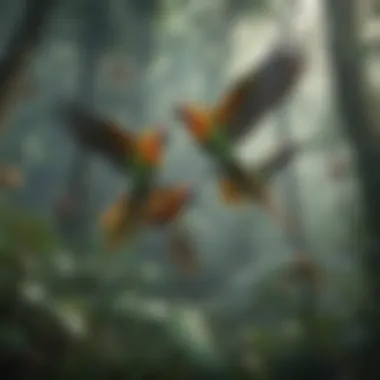

Interestingly enough, urban settings are becoming part of the experimental habitat range for many parrot species. Cities like Los Angeles and Sydney have seen an influx of parrots, demonstrating remarkable adaptability. In these environments, they find new food sources, from garden fruits to discarded human food.
The parakeet, once tied to the wild, has begun to thrive in city parks and on buildings. This shift is not without challenges, as urban environments often come with dangers, such as traffic and pollution. Nevertheless, these parrots showcase their remarkable problem-solving capabilities, often deciphering how to navigate their new landscapes while forming communities.
By looking at the lush rainforests, the expansive grasslands, and even the concrete jungles of modern cities, one can appreciate the adaptability of parrots and their reliance on diverse environments. Habitat is not merely a backdrop; it significantly contributes to their behavior, social structures, and ongoing survival. Understanding these aspects is essential for effective conservation efforts and creating awareness about their plight.
Behavioral Insights
Understanding the behavioral insights of parrots is crucial for anyone aiming to responsibly interact with these intelligent creatures. This topic sheds light on how parrots navigate their social worlds, communicate, and establish bonds with one another. Just as humans rely on verbal and non-verbal cues to convey feelings, so do these birds. As potential bird owners, comprehending these aspects can enhance our relationships with them, leading to a more fulfilling companionship.
Social Structures
Social structures among parrots play a pivotal role in their overall well-being. Unlike some solitary species, most parrots thrive in groups. This clustering provides not just safety but also opportunities for social learning and bonding. The dynamics within these groups can be intricate.
Mating Rituals
Mating rituals are fascinating behaviors that showcase the intrinsic social bonds parrots develop. These rituals are not merely about reproduction; they highlight the emotional connection between mates. During courtship, male parrots might engage in elaborate displays, including vocalizations and physical posturing, to woo a potential mate. The key characteristic of these rituals is their variety—they can range from intricate dances to vibrant displays of plumage.
This aspect is a beneficial choice for this article, as it demonstrates not just the biological imperatives but also the emotional dimensions of parrot life. A unique feature of mating rituals is how they reinforce pair bonds, fostering long-term relationships between mates. However, understanding these rituals also requires noting their disadvantages; too much emphasis on mating behavior might overshadow other social interactions crucial for overall group harmony.
Flock Dynamics
Flock dynamics refer to the complex social relationships and hierarchies formed within parrot groups. This behavior impacts how they interact with each other and their environment. Flocking offers not only safety in numbers but also an opportunity for social learning. Key characteristics include established hierarchies and cooperative behaviors that help them thrive.
Flock dynamics provide a popular choice for this article because they illustrate the social intelligence of parrots—how they negotiate roles and relationships. A unique feature involves their cooperative foraging behaviors, where individuals work together to find food. The drawback, however, is the potential for social stress; when hierarchies are disrupted, it can lead to conflicts among the flock.
Communication Methods
Parrots excel at communication, employing a range of methods to express themselves and interact with their surroundings. Their vocalizations and body language contribute significantly to their social interactions, providing depth to their behavioral patterns.
Vocalization Patterns
Vocalization patterns are one of the most remarkable aspects of parrot communication. They possess an ability to mimic sounds and even human speech, which serves both social and environmental functions. The key characteristic of these vocal patterns is their adaptability, as parrots can learn to adjust their calls based on situations or companions.
Vocalizations make a beneficial addition to this article since they underline not just species variability but also the bond birds form with their environment and each other. A unique feature is the role vocalizations play in maintaining social cohesion, allowing individuals to communicate over distances. On the flip side, excessive noise can be a drawback for owners, leading to potential issues with neighbors and household harmony.
Body Language
Body language is an equally important aspect of how parrots communicate. Unlike humans, they don't rely solely on vocalizations; their posture, feather positioning, and even wing movements convey messages. Understanding body language is essential for recognizing their emotional states. The key characteristic here is that body language can indicate happiness, stress, or aggression, making it a vital clue for parrot owners.
Incorporating body language into this article provides a beneficial perspective for pet owners, letting them gauge their parrots’ moods without solely depending on sound. A unique feature of body language is its subtlety; sometimes, a slight shift in posture can reveal a lot. However, the challenge lies in misinterpretation; not every move may translate clearly, requiring owners to learn and adapt over time.
Conservation Status
Understanding the conservation status of parrots is crucial as it reflects their health as a species and indicates the impact of human activities on their survival. Parrots are not just beautiful creatures; they play significant roles in their ecosystems, from seed dispersal to maintaining the balance of forest habitats. Therefore, when we explore the various aspects of the conservation status, we can see both the threats they face and the efforts being made to assure their continued existence. Given the diverse species and peculiar behaviors of parrots, tailoring conservation efforts is critical for their survival.
Threats to Parrot Populations
Habitat Loss
One of the most pressing threats faced by parrots is habitat loss. This phenomenon primarily arises from the deforestation, urbanization, and agricultural practices that obliterate their natural environments. As areas that once bustled with vibrant flora and fauna are transformed into concrete jungles or monoculture farms, parrots lose not only their homes but also their food sources. The stark reality is that once a habitat is lost, it seldom returns to its former state.
- Key Characteristic: Habitat loss is insidious; it often happens gradually, which can make it easy to overlook at first. Each fallen tree doesn’t just mean fewer perches or nesting spots, but a step toward ecosystem imbalance.
- Benefits of Understanding Habitat Loss: Raising awareness on this topic can foster not only local but global responsibility towards land conservation. Knowing the critical factors that contribute to habitat loss can empower individuals and communities to engage in protective measures.
- Unique Feature: One distinct aspect of habitat loss in relation to parrots is the role of climate change. As temperatures rise, the habitats suitable for many parrot species might shift or disappear altogether, impacting their populations directly and indirectly.
Illegal Trade
Another alarming threat to parrot populations is the illegal wildlife trade. This dark market capitalizes on the parrot’s popularity as pets, often resulting in the capture of wild birds, which can lead to significant declines in their populations. The demand for rare and colorful species drives countless birds into the hands of unregulated dealers.
- Key Characteristic: The illegal trade is often interconnected with organized crime, making it difficult to battle effectively. Captured birds are frequently subjected to horrendous conditions, impacting their health and future adaptability.
- Benefits of Understanding Illegal Trade: Recognizing the scale and impact of illegal trade can inspire policies that safeguard parrots. From stronger enforcement of existing laws to public awareness campaigns, every bit helps in the fight against this trade.
- Unique Feature: The emotional aspect of parrot ownership often leads to buyers not realizing they’re supporting illegal activities. Many people unknowingly purchase stolen birds, complicating the ethical landscape.
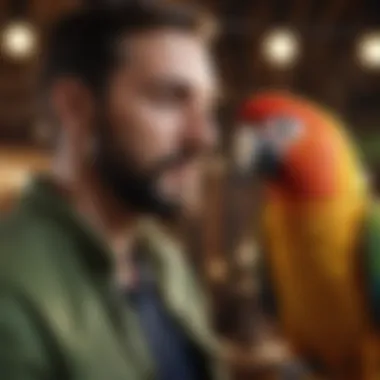
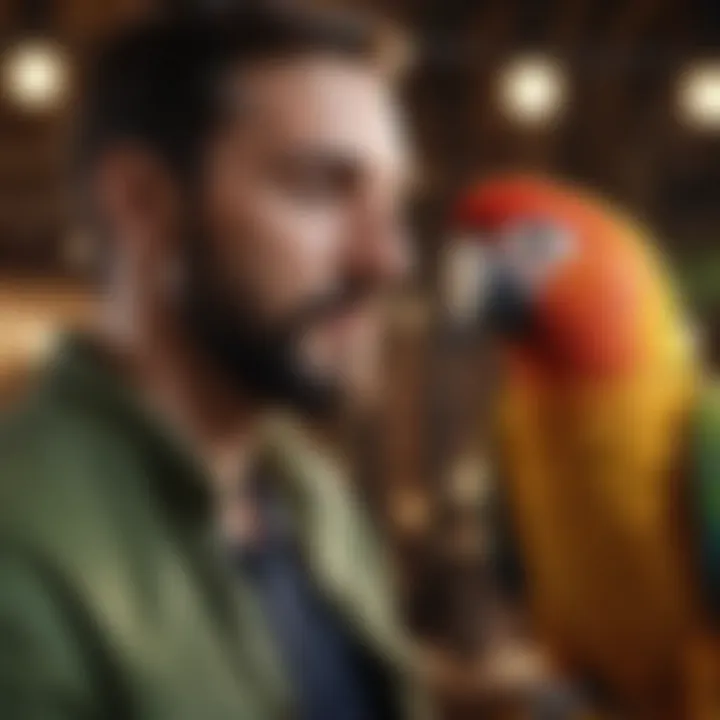
Conservation Efforts
Breeding Programs
Breeding programs stand out as a beacon of hope for parrot species at risk of extinction. These initiatives create sustainable settings to nurture + reintroduce species back into the wild, aiming to bolster dwindling populations. It’s a way of rekindling life where silence once reigned. A key component of these programs often involves pairing genetically diverse individuals to ensure robust offspring who may thrive in natural settings.
- Key Characteristic: Many breeding programs emphasize not just quantity, but quality. They focus on the mental and physical well-being of the birds, preparing them for eventual introduction into their habitats.
- Benefits of Breeding Programs: They provide a controlled environment, minimizing the risks of predation or disease present in the wild. Furthermore, they offer researchers invaluable insights into the breeding behavior of parrots.
- Unique Feature: These programs often partner with zoos and conservation organizations globally, creating a network of support that enhances genetic diversity efforts.
Habitat Restoration
Habitat restoration is an indispensable strategy when discussing conservation efforts. This process involves rehabilitating degraded environments to better support wildlife. It's about 'healing' the land and ensuring that parrots, along with countless other species, return to thrive in their native surroundings.
- Key Characteristic: Restoration efforts focus on key areas essential for parrot survival, such as planting native trees that parrots rely on for food and nesting.
- Benefits of Habitat Restoration: A successful restoration project can bring entire ecosystems back to life, supporting not just parrots but a plethora of other species as well. Plus, these initiatives often involve local communities, generating awareness and education about biodiversity.
- Unique Feature: Innovative techniques like rewilding are emerging, prioritizing ecological principles to allow the land to regain its natural state without significant interference.
Conservation status isn't just a science; it's a call to action. Understanding these dynamics gives us the knowledge to help protect these remarkable creatures.
Responsible Ownership
Owning a parrot is not like taking home a goldfish or a hamster. It’s a commitment, a leap into a vibrant and complex world. Responsible ownership is about understanding the magnitude of this relationship. It's essential for the well-being of both the bird and the owner, ensuring a harmonious living environment that respects the natural instincts and needs of these intelligent creatures.
When a potential owner decides to bring a parrot into their life, they must consider various factors carefully. Each species of parrot comes with its own distinct personality traits, dietary needs, and social requirements. This makes the selection process critical.
Also, the longer lifespan of parrots—many species can live for decades—means that owners need to think far ahead. A lifelong commitment and readiness to adapt to the bird's changing needs is what responsible ownership demands. The goal is not just to provide a home but to enrich a parrot's life and, by extension, the owner's experience.
Selecting the Right Species
Choosing the right species is akin to finding a compatible partner. Some parrots are more suited for beginners, while others may require experienced handling due to their complex needs. For example, Budgerigars are often recommended for first-time parrot owners due to their manageable size and friendly disposition. Conversely, African Grey Parrots, known for their intelligence, demand more attention and mental stimulation.
Keep in mind that each species has unique needs both physically and psychologically. Factors to consider include:
- Space Requirements: Different species need varying amounts of room to thrive.
- Social Behavior: Some breeds are more social than others, influencing interactions with humans and other pets.
- Noise Levels: Parrots can be quite vocal; understanding this is key to maintaining harmony at home.
The decision to select a parrot should involve thorough research and, if possible, engaging with current owners to glean first-hand experiences.
Care Requirements
Caring for a parrot is an intricate tapestry woven from several key threads. These include nutrition, social interaction, and mental stimulation. Getting it right means providing an enriching environment that allows the parrot to thrive.
Nutrition
Nutrition for parrots is crucial; it forms the foundation for their health and well-being. Each parrot species has different dietary requirements. Typically, their diet should be a balanced mix of
- Pelleted food: Specifically formulated to meet their nutritional needs.
- Fruits and Vegetables: Essential for vitamins; however, it’s important to know which are safe for parrots.
- Seeds and Nuts: While tasty, they should only account for a small part of their diet due to the high-fat content.
Proper nutrition contributes to overall health, from feather quality to longevity. Unfortunately, many new owners fall into the trap of feeding their birds a seed-only diet. This neglect can lead to nutritional deficiencies, resulting in severe health issues over time.
Social Interaction
Parrots are naturally social creatures, and their well-being is closely tied to their interaction with humans and other pets. Regular interaction helps prevent loneliness and related psychological issues. It’s vital to engage in various forms of interaction:
- Out-of-Cage Time: Encourage playtime outside their cage to explore and exercise.
- Bonding Activities: Things like talking, singing, or playing games can enhance the connection.
- Flock Dynamics: For those with more than one parrot, understanding how they interact and establish social hierarchies can help maintain peace.
Social interaction not only promotes mental health but also builds trust and eases the adaptability of the bird within its environment.
"Understanding their needs paves the way for a fulfilling companionship—it's what every responsible owner should strive for."
Ultimately, responsible ownership encompasses much more than just providing food and shelter. It means committing to a relationship that honors the parrot's unique nature, ensuring a healthy, happy life, and enriching the lives of both bird and owner in the process.
Closure
In summarizing the intricate world of parrots, we see that these vibrant birds are much more than mere companions—they are critical players in their ecosystems. Understanding the diversity among species, from the charming Budgerigars to the stately macaws, sheds light on the rich tapestry of avian life. As pet bird owners, aspiring bird parents, and bird breeders, it becomes paramount to grasp the wide-ranging characteristics and needs of different parrot species.
The information contained in this article serves several important purposes:
- Educational Resource: For current or potential parrot owners, this exploration aids in making informed choices about which species suits their lifestyle and environment best.
- Awareness and Conservation: It draws attention to the threats faced by many parrot species, emphasizing the need for responsible ownership practices and active participation in conservation efforts.
- Enhancing Experience: By recognizing the unique behaviors, habitats, and social structures of these birds, owners can offer richer living conditions, ensuring their parrot’s well-being.
Ultimately, this comprehensive look into the world of parrots highlights how crucial it is to respect and protect these creatures. The knowledge gained here fosters a deeper appreciation, enabling not just better care but also a commitment to supporting the conservation of the species in the wild. Each parrot that finds a home is a chance to experience the joy they provide. However, every owner must also remember their duty—caring for a parrot is not just a privilege but a responsibility carrying serious implications for the birds’ futures. The more we learn, the better we can ensure these remarkable birds thrive both in our homes and in their natural habitats.















